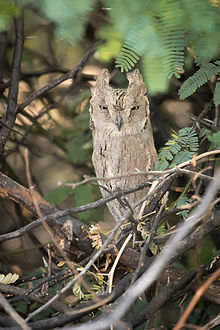Pallid scops owl
| Pallid scops owl | |
|---|---|

| |
| Individual at the Little Rann of Kutch | |
| Scientific classification | |
| Kingdom: | |
| Phylum: | |
| Class: | |
| Order: | |
| Family: | |
| Genus: | |
| Species: | O. brucei
|
| Subspecies: | O.b. brucei
O.b. obsoletus |
| Binomial name | |
| Otus brucei (Hume, 1873)
| |
The pallid scops owl (Otus brucei) is a small scops owl ranging from the Middle East to West and Central Asia, sometimes called the striated scops owl.
Description

The pallid scops owl is a small eared owl similar in appearance to the Eurasian scops owl but with more distinct streaks on the back and less intricate markings.
Distribution and habitat
The pallid scops owl ranges from the Middle East to West and Central Asia, with some populations moving as far as the Arabian Peninsula, Egypt, and Pakistan in the winter. It inhabits semi-open country with trees and bushes and has an estimated range of one to ten million kilometers.[2][failed verification]
There has been a few records from the state of Gujarat, Madhya Pradesh and Rajasthan in India. And a single record of this species from the southern state of Kerala which was found on a Paddyfields.
Behavior
Diet
Primarily an insectivore, the pallid scops owl's diet includes insects, lizards, spiders, and small mammals. It occasionally hunts during the day, and has been known to take bats and insects on the wing.[3]
Nesting
Breeding takes place any time between April and June, where 4 to 6 eggs are laid in a tree cavity, such as a woodpecker hole. Incubation takes approximately 27 days, and the juveniles are fledged at 30 days.
Voice
The pallid scops owl's call is a series of low, hollow, dove-like notes.

